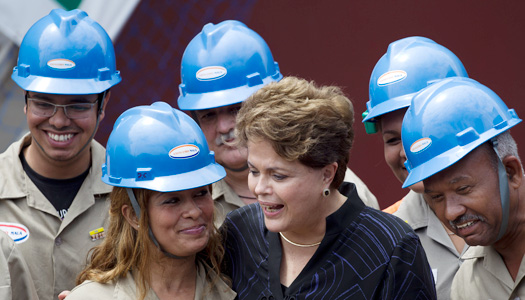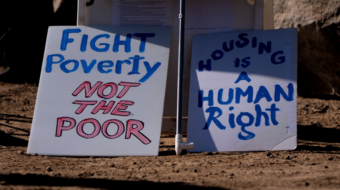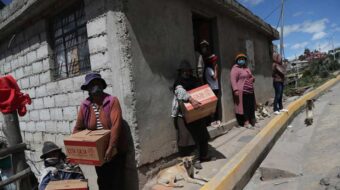
On one level, April’s hemispheric summit meeting was an old fashioned butt kicking for Washington’s policies in the region. The White House found itself virtually alone-Dudley Do Right Canada its sole ally-on everything from Cuba to the war on drugs. But the differences go deeper than the exclusion of Havana and the growing body count in Washington’s failed anti-narcotics strategy. They reflect profound disagreements on how to build economies, confront inequity, and reflect a new balance of power in world affairs.
Anger in Latin America
The backdrop for the summit is anger in Latin America over the failure of the U.S. and Europe to stimulate their economies, all the while pursuing policies that have flooded the region with money-a ” monetary tsunami” in the words of Brazilian President Dilma Rousseff-driving up the value of southern hemisphere currencies and strangling local industries.
After meeting last month with President Obama, Rousseff said she told him of Brazil’s “concern with the expansionary monetary policies of the rich countries…leading to the depreciation of developed countries While Latin American economies are in better shape than those in Europe and the U.S., the recession dogging the latter areas-plus the cooling of the Chinese economy-has slowed growth throughout much of Latin America. Brazil’s most recent figures indicate a stalled economy, which could have an impact on efforts by the Rousseff government to raise living standards and narrow what was once the world’s biggest gap between rich and poor.
According to the Getulio Vargas Foundation Brazil has lifted 33 million out of extreme poverty since 2003 and, out of a population of 190 million, has created a relatively well-paid workforce of some 105.5 million. In contrast to the U.S. and Europe, where the wealth gap is accelerating, income for the poorest 50 percent of Brazilians has risen 68 percent, while for the top 10 percent, it has grown only 10 percent.
This growth has come about because most countries in Latin America reject the economic model pushed by Washington and the European Union: free trade, financial deregulation, and deep austerity.
Argentina is the poster child for the region’s rejection of the so-called “Washington consensus.” Throughout much of the ’90s, a deeply indebted Argentina followed the strictures of the International Monetary Fund (IMF), slashing government spending and instituting a suffocating austerity. The result was a “debt trap”: cutbacks increased unemployment, which dampened tax revenues, which required yet more cutbacks, and more unemployment. In the end, debts went up. From 1998 to 2002, Argentina’s economy shrank 20 percent. By the time Buenos Aires finally said “enough” and defaulted on its $100 billion sovereign debt, half of its 35 million people were below the poverty line.
Argentina reversed course and primed the economy with government spending on housing, highways and education. It also subsidized 1.9 million low-income families, which cut poverty in half. Since 2002, the economy has grown at an average rate of 6 percent a year, and joblessness has fallen from 20 percent to 8 percent.
Brazil has followed a similar strategy that is now threatened by the fiscal and monetary policies of the U.S. and Europe. Those policies have caused the value of Brazil’s currency, the real, to grow, which prices Brazilian manufactured goods out of the international market.
“There is concern in South America about deindustrialization,” says Alicia Barcena of the UN Economic Commission for Latin America. “Therefore some countries are taking measures to support their productive sectors.” While the Obama Administration calls this support “protectionism,” Brazilian Finance Minister Guido Mantega says, “The measures we are using are to defend ourselves.”
The UN Security Council
There are other issues Latin Americans are unhappy about that never made it into U.S. media accounts on the summit, in particular the make-up of the permanent members of the United Nations Security Council that Brazil-along with India and South Africa-would like to join.
As former Brazilian President Luiz Lula da Silva told the African Union summit last July, “It isn’t possible that the African continent, with 53 countries, has no permanent representation in the Security Council. It isn’t possible that Latin America with its 400 million inhabitants does not have permanent representation. Five countries decide what to do, and how to do it.”
The five permanent members of the Security Council are the U.S., Britain, France, Russia, and China.
While the U.S. has endorsed India’s bid-in large part because it is wooing New Delhi to join its anti-China coalition-Washington has been consciously silent on Brazil’s bid. Indeed, United Nations U.S. representative Susan Rice has been sharply critical of Brazil, India and South Africa for not supporting intervention in Syria. “We have learned a lot [about these three countries] and frankly, not all of it encouraging.” The message is clear: back us and we will think about it.
Cuba
The summit was particularly critical of the Obama administration around the exclusion of Cuba, causing the President to turn positively peevish. “Sometimes I feel…we’re caught in a time warp, going back to the 1950s and gunboat diplomacy and Yankees and the Cold War.”
But from Latin America’s point of view, by maintaining a half-century-old blockade, it is the U.S. who seems locked into the world of the Cold War. And there are, indeed, some worries about “gun boats,” specifically those that make up the newly re-constituted U.S. Fourth Fleet, mothballed in 1950 and revived by the Bush Administration. The U.S. has also recently established military bases in Colombia and Central America.
Diplomacy?
The Brazilians are particularly nervous about the security of their newly found offshore oil deposits, and the head of the Brazilian Navy, Admiral Luiz Umberto de Mendonca, is pressing Brasilia for surface ships and submarines.
Testifying before the Brazilian House of Representatives, Simon Rosental of the prestigious Escuela Superior de Guerra (ESG) institute warned that “The world has known oil reserves that will only last 25 years and in the United States, only for the next ten years.”
It may be a bit of a stretch to imagine the U.S. actually threatening Brazil’s offshore oil deposits, but Latin Americans can hardly be blamed if they are a tad paranoid about the Colossus of the North. For the past 100 years the U.S. has overthrown governments from Guatemala to Chile, and supported military juntas throughout the region. Brazil only recently emerged from its own U.S.-backed dictatorship.
“South America,” says Moniz Banderia of the ESG, “is really trying to define its own identity, to differentiate itself from the United States, in opposition to its domination, which is evident in the creation of UNASUR [Union of South American Nations] and the South American Defense Council.”
UNASUR was established in 2008 and includes all 12 South American nations, plus observers from Panama and Mexico.
The Defense Council’s Action Plan 2012 aims to integrate the militaries of the region, establish a “peace zone” on the continent, and create a space agency, an essential step for launching satellites.
Certainly issues like Cuba, the war on drugs, and the tensions over Britain’s claim on the Malvinas/Falkland Islands are areas of friction between the U.S., Europe and South America. But it is in the realm of economics, poverty alleviation, and independent foreign policy that the differences are sharp.
South Americans tried the austerity model and found it wanting. They have also seen the U.S. and NATO spark wars in Afghanistan, Iraq, and Libya, and they are deeply suspicious of policy of “humanitarian intervention” in places like Syria because they don’t trust the motives behind it. Members of the BRIC countries, made up of Brazil, South Africa, India, Russia, and China, share those suspicions.
“There’s almost a third-world sense, a post-colonial sense,” says Mark Quarterman of the Center for Strategic and International Studies, “that they were meddled in, in ways that didn’t rebound to their benefit, and now the same countries are claiming humanitarian reasons for meddling.”
Thus in Libya, the UN enforced an arms boycott and an oil embargo on the Qaddafi regime, while the French supplied arms to the rebels and Qatar handled rebel oil sales. Brazil and other BRIC nations see a similar pattern in Syria. In the meantime, the U.S. and Europe are conspicuously silent on oil-rich Bahrain’s suppression of its Shiite majority and the lack of democracy in the monarchy-dominated Persian Gulf states.
So far the Obama Administration has responded to South America’s growing independence by increasing the U.S. military footprint in the region and acting churlish. While the leaders of India and South Korea got formal state affairs, the U.S. President gave Rousseff a two-hour meeting. “Obama could have taken her to dinner,” one Brazilian official complained to The Guardian (UK) “or to the Kennedy Center.”
But Latin Americans no longer pay as much mind to the atmosphere in Washington as they used to. They are too busy confronting poverty and underdevelopment, forging a multi-polar world in which the U.S. is looking increasingly out of touch.
This article originally appeared in Dispatches from the Edge.
Photo: Brazil’s President Dilma Rousseff talks with workers during a ceremony to deliver a ship for Transpetro, a subsidiary of the state-run oil company Petrobras in Niteroi, Brazil, Nov. 25, 2011. It is the first ship to be built by a Brazilian shipyard for Petrobras since 1997. Felipe Dana/AP










